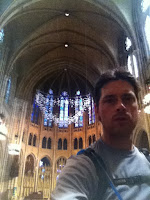- I predict that I'll learn about Dr. Seuss's life, some Springfield history, as well as his local inspirations.
- Does the museum put him into any larger contexts, such as an exhibit on his cartoons from WWII?
At the Museum:
 The most expensive museum that I've been to so far was the Intrepid Sea, Air, and Space Museum, which cost $28 with a AAA discount. The next most expensive entry fee was...you guessed it, the Dr. Seuss Museum, coming in at $25. To their credit, your entry fee does get you access to five museums within the Springfield Museum Group, but altogether, entry is way over priced and the five museums really only add up to one. On top of that, there was noticeable corporate sponsorship at every turn, which disrupts the flow of information and raises questions about corporate influence in planning and message thus compromising the integrity of the information.
The most expensive museum that I've been to so far was the Intrepid Sea, Air, and Space Museum, which cost $28 with a AAA discount. The next most expensive entry fee was...you guessed it, the Dr. Seuss Museum, coming in at $25. To their credit, your entry fee does get you access to five museums within the Springfield Museum Group, but altogether, entry is way over priced and the five museums really only add up to one. On top of that, there was noticeable corporate sponsorship at every turn, which disrupts the flow of information and raises questions about corporate influence in planning and message thus compromising the integrity of the information.
This museum was great for kids but had little value for adults desiring something more. If you want to see what Dr. Suess's living room looked like, or have a look at his writing desk, or learn a bit about his process then you're in luck. But if you want a deeper story that gets into the greater significance of Seuss you'll be disappointed. The one section that works in primary sources was a display of letters that he wrote but their main purpose is to show his real life whimsical sense of humor. In the museum, there is a historical element for kids, as the entire downstairs is set up as a fictionalized version of the Springfield that Seuss grew up in. However, that was way over my four and three year olds' heads.
 The most expensive museum that I've been to so far was the Intrepid Sea, Air, and Space Museum, which cost $28 with a AAA discount. The next most expensive entry fee was...you guessed it, the Dr. Seuss Museum, coming in at $25. To their credit, your entry fee does get you access to five museums within the Springfield Museum Group, but altogether, entry is way over priced and the five museums really only add up to one. On top of that, there was noticeable corporate sponsorship at every turn, which disrupts the flow of information and raises questions about corporate influence in planning and message thus compromising the integrity of the information.
The most expensive museum that I've been to so far was the Intrepid Sea, Air, and Space Museum, which cost $28 with a AAA discount. The next most expensive entry fee was...you guessed it, the Dr. Seuss Museum, coming in at $25. To their credit, your entry fee does get you access to five museums within the Springfield Museum Group, but altogether, entry is way over priced and the five museums really only add up to one. On top of that, there was noticeable corporate sponsorship at every turn, which disrupts the flow of information and raises questions about corporate influence in planning and message thus compromising the integrity of the information. This museum was great for kids but had little value for adults desiring something more. If you want to see what Dr. Suess's living room looked like, or have a look at his writing desk, or learn a bit about his process then you're in luck. But if you want a deeper story that gets into the greater significance of Seuss you'll be disappointed. The one section that works in primary sources was a display of letters that he wrote but their main purpose is to show his real life whimsical sense of humor. In the museum, there is a historical element for kids, as the entire downstairs is set up as a fictionalized version of the Springfield that Seuss grew up in. However, that was way over my four and three year olds' heads.
Family owned brewery until Prohibition, Kalmbach and Geisel.






